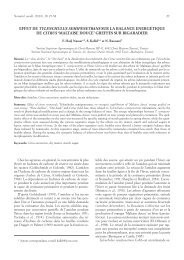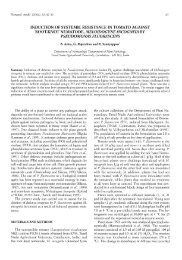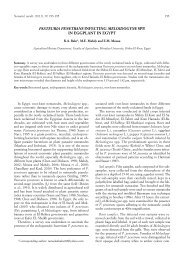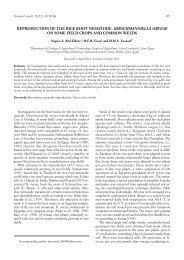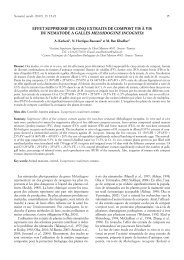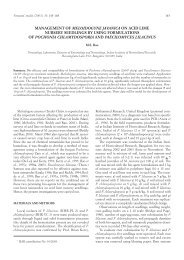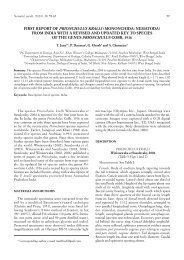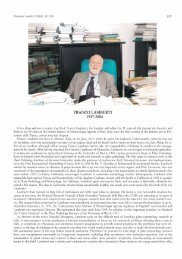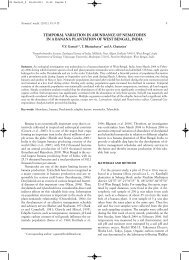GURURAJ KATTI, J.S. PRASAD, A.P. PADMAKUMARI and M ...
GURURAJ KATTI, J.S. PRASAD, A.P. PADMAKUMARI and M ...
GURURAJ KATTI, J.S. PRASAD, A.P. PADMAKUMARI and M ...
- No tags were found...
Create successful ePaper yourself
Turn your PDF publications into a flip-book with our unique Google optimized e-Paper software.
38Table I. Effect of storage periods on pathogenicity <strong>and</strong> multiplication of Rhabditis (Oscheius) sp. on Galleria mellonella <strong>and</strong>Corcyra cephalonica.Host speciesTreatmentStorage period (days)Time for host larval mortality(hrs)No. of EPNs recovered from hostlarvaMRG. mellonella 110 57.6 b 39955 b 399.6G. mellonella 50 65.6 b 48464 b 484.6G. mellonella 5 61.6 b 54482 a 544.8C. cephalonica 110 24.4 a 16566 c 165.7C. cephalonica 50 26.4 a 14646 c 146.5C. cephalonica 5 65.2 b 19019 c 190.2MR - Multiplication rate.Figures within a column followed by different letters are significantly different at P = 0.05, following DMRT.abad, India. Both Rhabditis (Oscheius) sp. <strong>and</strong> S. thermophilumwere maintained in vivo on two insect hostsviz., G. mellonella, reared on artificial diet as describedby Singh (1994) <strong>and</strong> C. cephalonica, reared on coarseSorghum bicolor (Ganguly, 2000) at the Directorate ofRice Research (DRR), Rajendranagar, Hyderabad. Theinfective juveniles of each EPN were harvested separatelyusing a modified White trap method (White,1927), surface sterilized with 0.1% formalin <strong>and</strong> storedin water (2000 IJs/ml) at room temperature (27-30 0 C).Effect of storage on survival of EPNs at room temperature.Freshly harvested IJs of Rhabditis (Oscheius) sp.<strong>and</strong> S. thermophilum were washed three times in tap water<strong>and</strong> stored in 100 ml distilled water in 250 ml conicalflasks at a concentration of 2000 IJs/ml. Formalin(0.1%) was added to avoid contamination <strong>and</strong> the flaskswere plugged with non-absorbent cotton. Treatmentswere storage periods for 50, 80, 100, 135 <strong>and</strong> 150 daysat 28 ± 2 0 C, arranged according to a completely r<strong>and</strong>omizedblock design, with five replicates per EPNspecies <strong>and</strong> storage period. The survival of IJs was monitoredby counting active nematodes at the end of eachstorage period (Krishna Prasad <strong>and</strong> Rao, 1980). The percent survival of EPNs was then calculated.Effect of storage on the infectivity of EPNs. After storageat room temperature for varying periods, the twospecies of EPNs were evaluated for their infectivity,pathogenicity <strong>and</strong> multiplication rate on final instar larvaeof G. mellonella <strong>and</strong> C. cephalonica.Nematode samples were maintained at 28 ± 2 0 C infive batches for storage periods of 5, 50 <strong>and</strong> 110 daysfor Rhabditis (Oscheius) sp. <strong>and</strong> of 5, 50, 100 <strong>and</strong> 150days for S. thermophilum. Suspensions of infective juveniles(100 IJs/ml) were pipetted onto moist filter paperplaced in 2.5-cm-diameter Petri-plates. A single larva ofthe host was then placed in each Petri-plate for exposureto each EPN for 12 h. After exposure, the larvaewere washed with formalin (0.1%) <strong>and</strong> transferred tofresh Petri-plates containing food. Partially groundsorghum grains were provided to C. cephalonica (25g/larva) <strong>and</strong> solid artificial diet was provided to G. mellonella(25 g/larva). Observations on infectivity weremade at six-hour intervals until 100% larval mortalitywas observed in all the treatments. Only the time takenfor 100% mortality was considered in analysis of the data.The dead insect larvae were carefully placed onWhite traps <strong>and</strong> the IJs that emerged (White, 1927)were counted by dilution count under a stereozoom microscope.The data were analysed by ANOVA <strong>and</strong>means were compared by Duncan’s Multiple Range Test(DMRT).RESULTSEffect of storage on survival of EPNs at room temperature.The survival of IJs of EPNs under storage variedbetween the two species. There was 100% survival ofboth isolates up to 50 days of storage at room temperature.Thereafter, survival of Rhabditis (Oscheius) sp. decreasedto 75%, 50%, 30% <strong>and</strong> zero after 80, 100, 135<strong>and</strong> 150 days of storage, respectively. Survival of S. thermophilumwas 80%, 75%, 50% <strong>and</strong> 10% after 80, 100,135 <strong>and</strong> 150 days of storage, respectively (Fig. 1).Effect of storage on the infectivity of EPNs. The timetaken by Rhabditis (Oscheius) sp. to kill the insectsranged from 57.6 to 65.6 h for G. mellonella <strong>and</strong> from24.4 to 65.2 h for C. cephalonica, after periods of storagevarying from 5 to 110 days (Table I). Significantly moreRhabditis (Oscheius) sp. IJs were recovered from G.mellonella (39956 to 54482/larva) than from C.cephalonica (14646 to 19019/larva).Steinernema thermophilum also took more time tokill G. mellonella (20.8 to 74.4 h) than C. cephalonica(19.6 to 57.2 h), after periods of storage varying from 5
Gururaj Katti et al. 39DISCUSSIONFig. 1. Survival of the EPNs under different storage periods inthe laboratory. Bars represent st<strong>and</strong>ard errors.to 150 days (Table II). The IJs stored for 100 days tookleast time (20.8 h) to kill G. mellonella, while storage ofIJs for periods as long as 150 days or as short as 50 or 5days required significantly more time (36.8 to 74.4 h).The IJs stored for 50 or 100 days required the least time(19.6 to 25.6 h) to kill C. cephalonica followed by IJsstored for 150 days (50.4 h) <strong>and</strong> 5 days (57.2 h). The recoveryof S. thermophilum was greater from G. mellonella(36033 to 49298/larva) than from C. cephalonica(24161 to 28154/larva).The multiplication rate of both nematode species wassimilar on G. mellonella except for Rhabditis (Oscheius)sp. stored for 110 days. When compared to Rhabditis(Oscheius) sp., S. thermophilum had a slightly highermultiplication rate on C. cephalonica.Steinernema thermophilum survived better thanRhabditis (Oscheius) sp. at room temperatures. Selvan etal. (1993), studying the shelf life of Heterorhabditis bacteriophoraPoinar <strong>and</strong> S. glaseri (Steiner) Wouts,Mracek, Gerdin et Bedding, which survived for 7 <strong>and</strong>36 weeks, respectively, deduced that poor storage stabilityin entomopathogenic nematodes could be due to anincrease with storage of unsaturated fatty acids in thefreshly emerged infective juveniles. The differences insurvival <strong>and</strong> infectivity of the two EPNs could also bedue to difference in activity of the IJs under storage(Hussaini et al., 2005).There was no significant effect of the storage periodof IJs on time taken by Rhabditis (Oscheius) sp. to killG. mellonella, while the time necessary to kill C.cephalonica decreased with increase in storage time. TheIJs of S. thermophilum stored for 50 <strong>and</strong> 100 days weresignificantly more effective than those stored for 5 <strong>and</strong>150 days in killing both hosts. Jung (1996) reported lowinfectivity of EPN isolates during the first week ofemergence. Lewis et al. (1997) also observed that IJs ofS. carpocapsae became more mobile with age, whileO’Leary et al. (1998) found that the host finding abilityof IJs of H. megidis improved with increased durationof storage.Galleria mellonella larvae yielded significantly moreIJs of S. thermophilum than the larvae of C. cephalonica,but storage periods did not affect the recovery of IJs.Rajkumar et al. (2003) also observed greater recovery ofIJs of Heterorhabditis sp. from G. mellonella in comparisonto Steinernema sp., while Zaki et al. (2000) observedno differences in recovery of IJs of Steinernemasp. <strong>and</strong> Heterorhabditis sp. from Bombyx mori.The survival of Rhabditis (Oscheius) sp. <strong>and</strong> S. thermophilumdeclined after 50 days of storage. AlthoughTable II. Effect of storage periods on pathogenicity <strong>and</strong> multiplication of Steinernema thermophilum on Galleria mellonella <strong>and</strong>Corcyra cephalonica.Host speciesTreatmentStorage period (days)Time for host larval mortality(hrs)No. of EPNs recovered from hostlarvaMRG. mellonella 150 74.4 c 48977 a 489. 8G. mellonella 100 20.8 a 49298 a 493.0G. mellonella 50 36.8 b 36033 a 360.3G. mellonella 5 60.8 c 41575 a 415.7C. cephalonica 150 50.4 b 24161 b 2416.1C. cephalonica 100 25.6 a 24744 b 247.4C. cephalonica 50 19.6 a 27432 b 274.3C. cephalonica 5 57.2 c 28154 b 281.5MR - Multiplication rate.Figures within a column followed by different letters are significantly different at P = 0.05, following DMRT.
40the infectivity of Rhabditis (Oscheius) sp. increased afterlonger storage, in C. cephalonica there was no significanteffect of storage period on the recovery of nematode. InS. thermophilum, the IJs took less time to kill whenstored for 50-100 days, irrespective of the host. The recoveryof IJs was more in G. mellonella than C.cephalonica. However, within each host the storage periodhad no significant effect on the recoveries of S. thermophilum.As both EPNs are amenable to quick <strong>and</strong>easy multiplication, studies to further improve their shelflife could contribute to the development of appropriatedelivery systems for field management of rice pests.Awareness of hazards caused by the usage of chemicalsin agriculture, is increasing the dem<strong>and</strong> for pesticide-freeproduce in India, particularly in northern areaswhere quality rices <strong>and</strong> basmati varieties are grownmainly for export purposes. In these areas, stem borer<strong>and</strong> leaf folder are the major insect pest problems <strong>and</strong>the farmers are being encouraged to resort to non-pesticidal<strong>and</strong> organic inputs for their management. Withthe identified potential of the EPNs <strong>and</strong> the added advantageof organic rice attracting premium prices, developmentof EPNs as a component in rice pest managementwill be economically beneficial to the farmers.LITERATURE CITEDCRRI, 1975. Annual Report, Central Rice Research Institute,Cuttack, India, 384 pp.CRRI, 1977. Annual Report, Central Rice Research Institute,Cuttack, India, 265 pp.Ganguly S., 2000. Life cycle of an indigenous strain of entomopathogenicnematode, Steinernema sp. National NematologySymposium on Integrated Nematode Managementfor Sustainable Agricultural in the Changing Agri-ecological<strong>and</strong> Economic Scenario in the New Millenium. November23-24, 2000. Nematological Society of India,Bhubaneswar, Orissa, India, pp. 9-10.Georgis R., 1987. Nematodes for biological control of urbaninsects. Pp. 816-821. In: 194 th Meeting, American ChemicalSociety, New Orleans, Vol. 27.Gururaj Katti, Padmakumari A.P. <strong>and</strong> Prasad J.S., 2003. Anentomopathogenic nematode infecting rice yellow stemborer, Scirpophaga incertulas (Walker). Indian Journal ofPlant Protection, 31: 80-83.Hussaini S.S., Nagesh M. <strong>and</strong> Shakeela V., 2005. Survival ofinfective juveniles of entomopathogenic nematodes understorage <strong>and</strong> their infectivity against Galleria mellonella <strong>and</strong>Spodoptera litura. Indian Journal of Plant Protection, 33:64-67.Israel R., Rao Y.R.V.J., Prakasa Rao P.S. <strong>and</strong> Verma A., 1969.Control of paddy cutworm by DD -136, a parasitic nematode.Current Science, 16: 390-391.Jung K., 1996. Storage of entomopathogenic nematodes of thegenus Heterorhabditis at two temperatures. Effect on infectivity,energy reserve <strong>and</strong> number of bacteria. Bulletin ofthe International Organization for Biological <strong>and</strong> IntegratedControl of Noxious Animals <strong>and</strong> Plants, 19(9): 103-106.Kaya H.K., 1985. Entomogenous nematodes for insect controlin IPM systems. Pp. 283-302. In: Biological Control inAgricultural Systems (Hoy M.A. <strong>and</strong> Herzog D.C., eds).Academic Press, New York, USA.Kaya H.K., 1990. Entomopathogenic nematodes in biologicalcontrol. Pp. 93-116. In: Soil Ecology (Gaugler R. <strong>and</strong> KayaH.K., eds). CRC Press, Boca Raton, Florida, USA.Klein M.G., 1990. Efficacy against soil-inhabiting insect pests.Pp. 195-214. In: Entomopathogenic nematodes in Biologicalcontrol (Gaugler R. <strong>and</strong> Kaya H.K., eds). CRC Press,Boca Raton, Florida, USA.Krishna Prasad K.S. <strong>and</strong> Rao Y.S., 1980. Relative toxicity ofchemicals to infective larvae of rice root-knot nematode,Meloidogyne graminicola. Indian Journal of Nematology,10: 216-224.Lewis E.E., Campbell J.F. <strong>and</strong> Gaugler R., 1997. The effect ofaging on the foraging behaviour of Steinernema carpocapsae(Rhabditida: Steinernematidae). Nematologica, 43: 355-362.Mason J.M. <strong>and</strong> Wright D.J., 1997. Potential for the controlof Plutella xylostella larvae with entomopathogenic nematodes.Journal of Invertebrate Pathology, 70: 234-242.Matteson P.C., 2000. Insect pest management in tropicalAsian irrigated rice. Annual Review of Entomology, 45:549-574.Moh<strong>and</strong>as C. <strong>and</strong> Rajamma P., 2005. Rhabditis (Oscheius) sp.-A new entomopathogenic nematode. Pp. 168-174. In:Biotechnological management of nematode pests <strong>and</strong>scope of entomopathogenic nematodes (Sithanantham S.,Vasantha Raj, David B. <strong>and</strong> Selvaraj P., eds). Sun AgroBiotech Research Center, Chennai, India.Moh<strong>and</strong>as C., Sheeba Mathews, Firoza A.J. <strong>and</strong> Rajamma P.,2005. Bacteria associated with Rhabditis (Oscheius) spp.(Rhabditidae: Nematoda) for the biocontrol of insect pests.National Seminar on Achievements <strong>and</strong> Opportunities inPost-harvest Management <strong>and</strong> Value Addition in Root <strong>and</strong>Tuber Crops. Central Tuber Crops Research Station,Kayankulam, Kerala, India, pp. 79-80 (abstract).Nayak P., Rao Y.R.V.J., Yadava C.P. <strong>and</strong> Rao Y.S., 1977. Occurrenceof a new entomophilic nematode on rice stemborer, Sesamia inferens. Oryza, 14: 51-54.O’Leary S.A., Stack C.S., Chubb M.A. <strong>and</strong> Burnell A.M.,1998. The effect of day of emergence from the insect cadaveron the behavior <strong>and</strong> environmental tolerances of infectivejuveniles of the entomopathogenic nematode Heterorhabditismegidis (strain UK211). Journal of Parasitology,84: 665-672.Prasad J.S., Katti G., Padmakumari A.P. <strong>and</strong> Pasalu I.C.,2003. Exploitation of indigenous entomopathogenic nematodesagainst insect pests of rice. Pp. 121-126. In: Currentstatus of research on entomopathogenic nematodes in India(Hussaini S.S., Rabindra R.J. <strong>and</strong> Nagesh M., eds).Project Directorate of Biological Control, Bangalore, India.Rahman P.F., Sharma S.B. <strong>and</strong> Wightman J.A., 2000. A reviewof insect parasitic nematodes research in India 1927-1997. International Journal of Pest Management, 46: 19-28.Rajkumar, Aruna P. <strong>and</strong> Siddiqui A.U., 2003. In vivo culturingof indigenous entomopathogenic nematodes fromUdaipur. Indian Journal of Nematology, 33: 171-196.
Gururaj Katti et al. 41Rao V.P. <strong>and</strong> Manjunath T.M., 1966. DD-136 nematode thatcan kill many pests. Indian Farming, 16: 43-44.Rao Y.R.V.J., Prakasa Rao P.S., Verma A. <strong>and</strong> Israel P., 1971.Tests with an insect parasitic nematode DD-136 (Nematoda:Steinernematidae) against rice stem borer, Tryporyza incertulasWalk. Indian Journal of Entomology, 33: 215-217.Selvan S., Gaugler R. <strong>and</strong> Grewal P.S., 1993. Water content<strong>and</strong> fatty acid composition of infective juveniles of entomopathogenicnematodes during storage. Journal of Parasitology,79: 510-516.Singh S.P., 1994. Technology for production of natural enemies.Technical Bulletin No.14, Project Directorate of BiologicalControl (PDBC), Bangalore, India, 182 pp.White G.F., 1927. A method for obtaining infective juvenilesfrom cultures. Science, 66: 302-303.Yadava C.P. <strong>and</strong> Rao Y.S., 1970. On the effectiveness of entomopathogenicnematode DD-136 in the biological controlof insect pests of rice. Oryza, 7: 131-136.Zaki F.A., Mantoo M.A., <strong>and</strong> Gul S., 2000. In vivo culturingof entomopathogenic nematodes Heterorhabditis bacteriophora<strong>and</strong> Steinernema carpocapsae on silk worm (Bombyxmori) <strong>and</strong> their effect on some lepidopterous insects. IndianJournal of Nematology, 30: 1-4.Accepted for publication on 20 March 2006.





